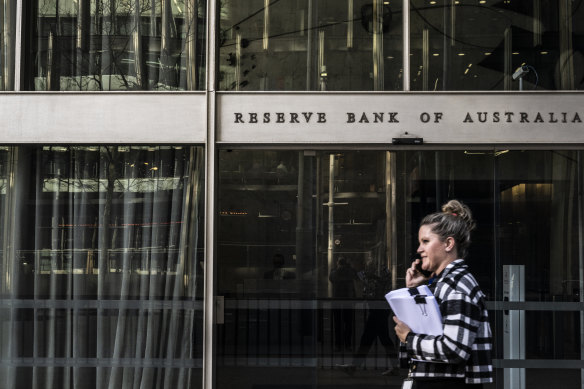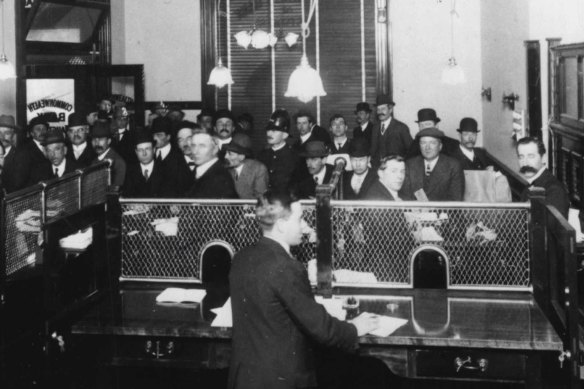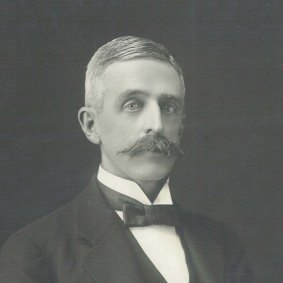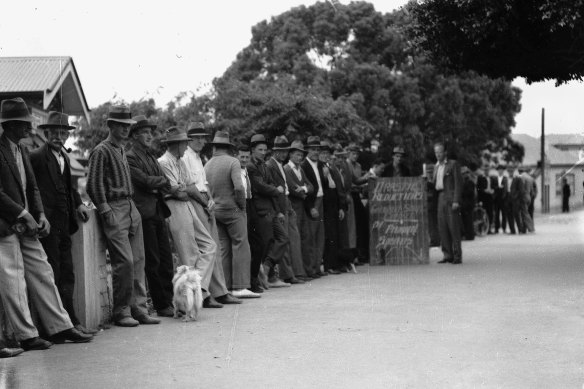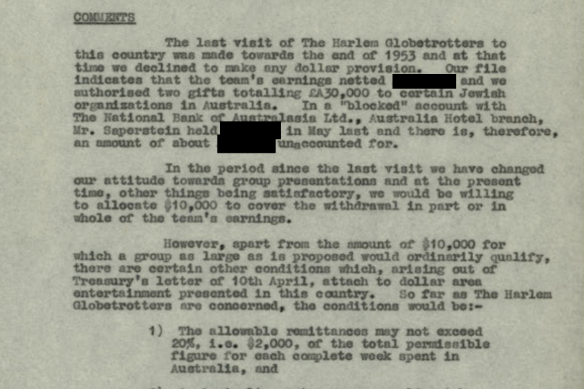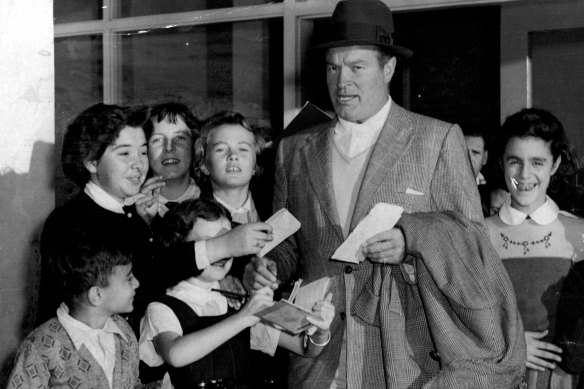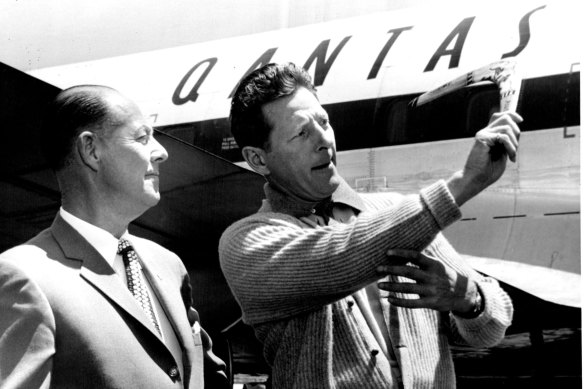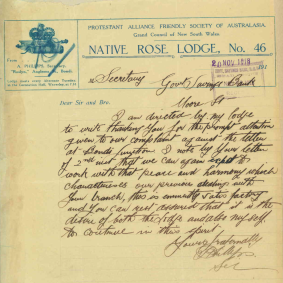Bob Hope, Danny Kaye and the Harlem Globetrotters: all under the RBA’s watchful eye
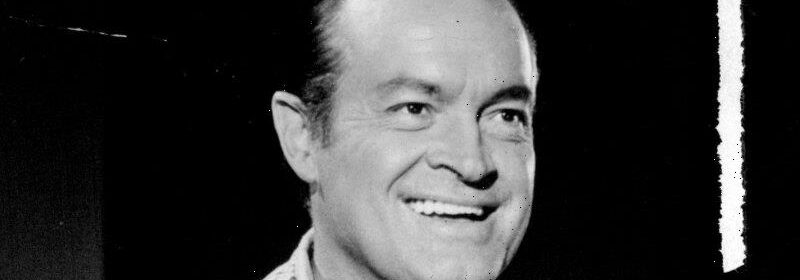
It’s hard to imagine Reserve Bank governor Philip Lowe roaming his Martin Street headquarters with a revolver holstered to his hip.
But 90 years ago, staff at one of the RBA’s many forerunners expected its male employees to be properly trained in firing their bank-issued revolver.
RBA governor Philip Lowe is an unlikely gunslinger.Credit:AAP
A revolver training manual of the Government Savings Bank of NSW, issued in March 1931, makes clear what was expected.
Every year, “2-3 men” branches were to fire off 40 practice rounds from their six-shooters. Branches with four men were expected to fire 32 shots a year.
Over a distance of 10 yards, or 9 metres, the men were expected to hit the centre of a 40 centimetre by 30 centimetre piece of card or “to improvise on a tree”.
Across the bank’s almost 190 NSW branches, staff were expected to make loans, look after customers as well as ensuring they passed a “dry, clean flannelette” through the bore of their weapon at least once a month.
The training manual, issued just weeks before the Government Savings Bank was shut down and then absorbed into the Commonwealth Bank, is just one of hundreds of thousands of archives now held by the Reserve Bank.
A section of the revolver training manual of the Government Savings Bank of NSW, issued in March 1931.Credit:RBA archives 6-1S-3-8
Those archives give an insight not just into the dry world of central banking but also into the history of Australia.
They take up about half a floor of the bank’s Martin Place headquarters. To some inside the bank, the archival area is like a scene out of Raiders of the Lost Ark. Elements of the archives are actually stored away under security due to their sensitive nature, such as its collection of currency and the design notes to them. They are of long-standing interest to people who may design Australia’s next generation of notes.
The Reserve Bank formally started in 1960. Before that date, the Commonwealth Bank (created in 1911) operated as the nation’s central bank.
Inside the RBA’s Martin Place headquarters is a treasure trove of historic documents.Credit:Louise Kennerley
The Commonwealth absorbed a number of other institutions while it was the nation’s central bank. This included the Government Savings Bank of NSW (created in 1871) which itself had absorbed one of the nation’s first banks, Campbell’s Bank (or the Savings Bank of NSW) that was set up in 1819).
Convicts transported to Sydney were required to deposit their savings in Campbell’s Bank, giving the RBA archives a direct link to the days of governor Lachlan Macquarie.
It means the bank has the banking details of Mary Reibey, the horse stealer-turned-businesswoman who features on the nation’s $20 note, explorer Ludwig Leichhardt and artist Conrad Martens who had sailed on HMAS Beagle with its famous passenger, a young Charles Darwin.
But beyond the well-known are the ordinary voices of Australians.
Banking records of convict-turned-entrepreneur, Mary Reibey, are held by the Reserve Bank archives. She features on the nation’s $20 note.Credit:Stephen Hadley
In 1920, the secretary of the Government Savings Bank received a handwritten note from Ann Cornwall saying that she would supplement her son’s income so that he would earn 200 pounds annually.
She said this would ensure he had “a sufficient income to undertake matrimony”. The idea was agreed to by the bank.
Three years earlier, an anonymous note had come in about one of the bank’s managers, accusing him of pro-German sentiment who was also opposed to that year’s conscription vote.
A police investigation followed which cleared the manager of being unpatriotic.
During World War 1, the Commonwealth Bank’s first governor, Sir Denison Miller, would often write to the many staff who volunteered to fight.
The first branch of the Commonwealth Bank of Australia on the day the bank was inaugurated.Credit:Fairfax
The archives contain the letters and their responses, including from Hobart bank official Ernest Smith who landed on the Gallipoli Peninsula on April 25, 1915.
In a letter dated June 27, from a place “near Gaba Tepe”, Smith told Miller of constant bombardments and how he had survived. “My clothing & equipment was perforated in no less than six places. One learns rapidly however, the art of this warfare and does not waste much time in not taking precautions. The main thing is to get underground if you want to live,” he wrote.
Sir Denison Miller lost one of his sons during WWI.
Smith and others would gratefully receive Miller’s replies. Miller had a deep interest in the events in Europe – three of his sons had volunteered to fight. One of them, Clive, would die in action at Messines in Belgium in July 1917.
In 1931, during the depths of the Great Depression, which the Commonwealth Bank had exacerbated with its support of deflationary policies, banking staff endured a 25 per cent cut in their wages.
There was also “rationing” of work to deal with the drop in staff that was forced upon the bank.
That prompted a complaint about the workload on staff. “Under normal conditions the department functions like a well-oiled machine, but without the assistance of experienced officers, there are occasions when chaos reigns supreme,” they wrote.
The term “chaos” prompted a string of notes between staff that, while acknowledging the shortage of bankers, rebuffed any suggestion the bank was facing “chaos”. Australia’s deflationary policies, encouraged by the most senior members of the Commonwealth Bank, contributed directly to the nation’s unemployment rate sitting above 30 per cent.
The bank’s deflationary policies contributed to the unemployment rate during Great DepressionCredit:State Library of Queensland
Well before Australians could turn their dollars into pounds or euros or yen with a touch of their smartphone, there were very heavy restrictions on the movement of currency out of the country so that it could control the value of the currency. Americans living or visiting here could only remit $US10,000 a year.
The controls on foreign exchange movement generated mountains of paper work that now sits in the archives.
People as well known as Bob Hope, Frank Sinatra, Katharine Hepburn, Louis Armstrong and even the Harlem Globetrotters are recorded in the archives because they had to move money out of Australia.
The Globetrotters toured in 1953, making a very sizeable profit. The RBA rejected a request by the Globetrotters’ management to make an extra withdrawal of American dollars.
The official note revealing just how much money the Harlem Globetrotters had to leave in Australia.Credit:RBA archives B.1.1.C.41.2.
That meant “excess” earnings by the players remained in Australia. More than two years later, with the Globetrotters looking to return, a note contained in the archives revealed just how much money the group were forced to leave in Australia. “Our file indicates that the team’s earnings netted (blanked out) and we authorised two gifts totalling $A30,000 to certain Jewish organisations in Australia,” it noted.
Issues around two artists – Hope and American actor, comedian and singer Danny Kaye – went all the way to the Menzies government.
Hope, who in the 1950s was one of the world’s biggest stars, wanted to tour Australia. But this provoked concern among Australia’s promoter and theatrical community that he would shift far more than the $US10,000 limit back to his homeland.
Jack Graham, secretary of the Theatrical Proprietors’ and Managers’ Association of Australia, wrote to the then labour minister Harold Holt, suggesting Hope be cross-examined about his contract and movement of American dollars.
Bob Hope is mobbed by autograph hunters arriving in Sydney in 1955.Credit:Fairfax
According to Graham, the industry “knew” that Hope would earn far more than $US10,000 on his Australian tour. Somehow, the man known for singing with Bing Crosby was also an involved in the movement of currency around the world.
“We have known for some time that money in excess of the 10,000 dollar limit has been finding its way to America, but the trouble has been to obtain proof,” Graham told Holt on May 5, 1955.
Graham said Herbert “Nugget” Coombs, the head of the Commonwealth Bank (which was Australia’s central bank at the time), knew of the issue.
“We cannot understand why the Commonwealth Bank are finding it difficult to crack down on this sort of thing – but Dr Coombs seems to be at a loss to know how the money is being got away,” he wrote.
“Their powers of investigation are very wide and we would have thought that the production of Hope’s contract, together with the cross-examination of Hope and his promoter, would have revealed the true state of affairs.
“We cannot imagine that Hope would ever say under cross-examination that he was only receiving (blanked out) dollars (gross) for his Australian trip, as this would tend to lower his ‘selling price’ elsewhere.”
The bank would reply to both Holt and then treasurer Arthur Fadden that it could find no evidence of Graham’s claims. It examined contracts of overseas performers, in part because of ongoing concerns that American artists in particular appeared to be paid far more in their home country than they were permitted to move out of Australia.
Holt would make a successful tour of the country soon after Graham’s letter.
A year later, Fadden was dealing with concerns about Danny Kaye. In this case, the issue became an argument between Fadden and then (ALP) NSW housing minister Abe Landa who was very supportive of Kaye making a tour of Australia.
According to Landa, Kaye was “one of the greatest ambassadors of goodwill in relationship between Australia and the USA” who should be permitted to remit back to America more than $US10,000.
Danny Kaye as denied permission to take more than $US10,000 out of Australia.Credit:UPI Photo
But Fadden stood by the policy of the day, admitting the best that could be done for Kaye was the remittance of $US1500 a week up to a maximum of $US7500.
“I regret that it is not possible at this present stage to meet Mr Kaye’s conditions for a visit to Australia. You will appreciate, however, that a special exception cannot be made in his case, despite his pre-eminence in the entertainment field and his undoubted contribution to the United Nations activities,” Fadden replied.
While the archives, overseen by a small dedicated team, give insights into the social history of the country, they are also used by the Reserve Bank’s economists for more pressing issues.
Bank ledgers have been digitised, enabling the use of the data to track transactions of ordinary Australians during key periods of the nation’s history.
RBA economists Gianni La Cava and Fiona Price last year published research based on archives from the depressions of the 1890s and 1930s. They found net withdrawal levels increased as interest rates fell and when public confidence in the financial system deteriorated.
It also found transactions through savings accounts was relatively rare, as people used them for “significant life events”.
Bank governor Philip Lowe said the archives were unique insight into the nation’s economic and financial history. “As a primary source of information, they enable researchers from many different disciplines to make new observations about Australia’s history – and not just our economic history, but what was happening in our society, our workplaces and our built environment at the time economic events were occurring,” he said.
A thank-you letter to the Government Savings Bank for disciplining a rude staff member.Credit:RBA Archives 6-1C-1-27
“It is also an important resource for the bank, which we have used to learn lessons from history.”
One of those lessons is enduring – always treat your customers well.
In 1918, the Government Savings Bank received a complaint from the Native Rose Lodge of the Protestant Alliance Friendly Society. Friendly societies were important in providing charity and support in a period well before the advent of unemployment benefits and similar welfare.
The society was upset at the treatment by a particular teller from the bank’s Bondi Junction branch, who was described as “discourteous” and “boorish”.
The complaint went through the bank including to its commissioners. The teller defended his position, arguing he had gone to extreme efforts to explain the problems with the way society members were depositing money at the branch.
But it was to no avail. The branch manager wrote to the teller, saying that the issue was due entirely “to your manner in dealing with this and other accounts”.
“[The commissioners] have decided to arrange for your transfer to a position where you will not come in contact with the public, but as it will be impossible to keep you for any length of time in such a position, your manner must alter if you wish to remain in the bank’s service,” the manager wrote.
There’s no mention of whether the teller kept his revolver.
The Morning Edition newsletter is our guide to the day’s most important and interesting stories, analysis and insights. Sign up here.
Most Viewed in Politics
From our partners
Source: Read Full Article


